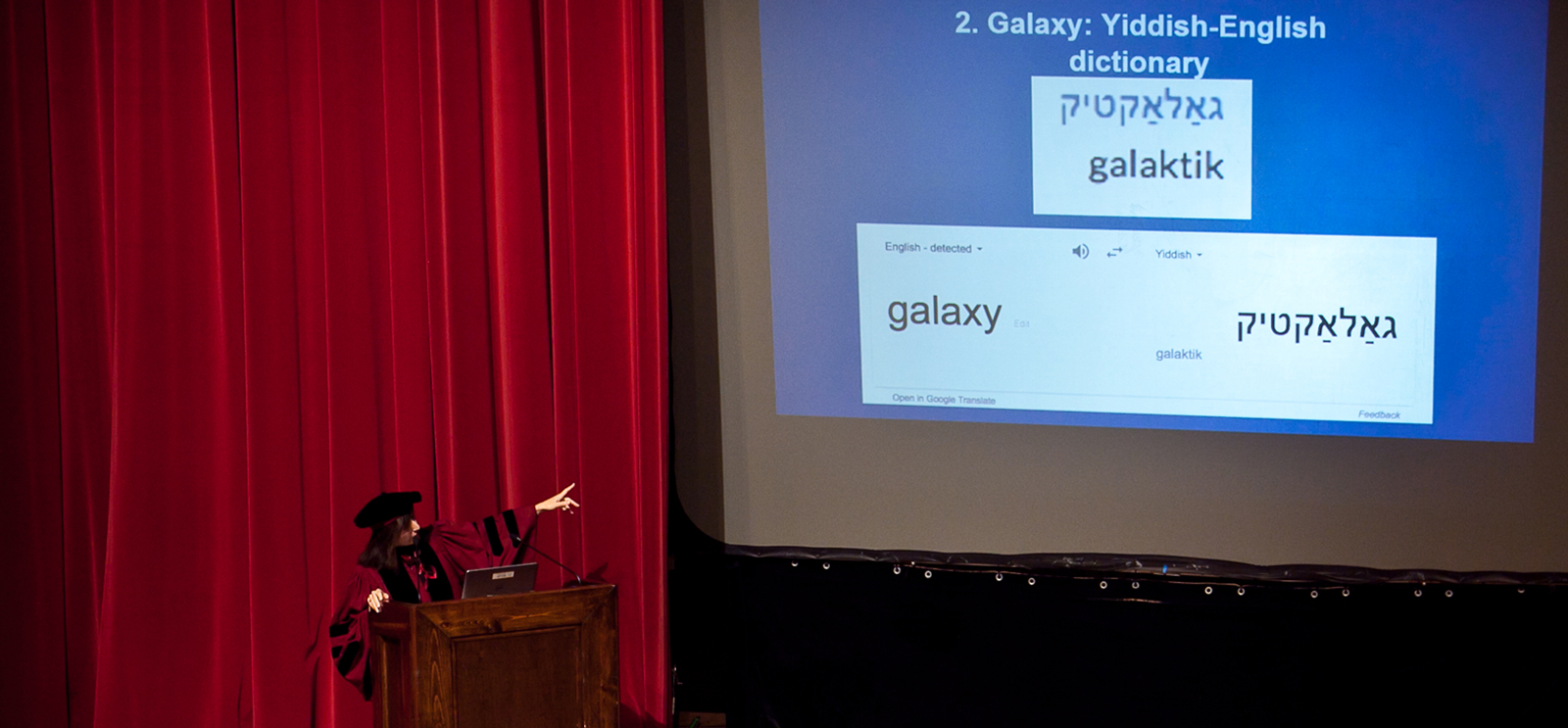
Wendy Freedman, professor of astronomy and astrophysics, was the first debater of the night at the 70th annual Latke-Hamantash Debate on Tuesday, November 22, 2016. Photography by Eddie Quinones.
Professor Wendy Freedman applies astrophysics expertise to the Latke-Hamantash Debate.
In November UChicago Hillel hosted the 70th annual Latke-Hamantash Debate, during which faculty members applied their expertise to champion traditional Jewish foods: the latke, a fried potato pancake eaten during Hanukkah, or the hamantash, a three-cornered pastry stuffed with poppy seeds or fruit preserves eaten on Purim.
This year the debaters included David Nirenberg, dean of the Social Sciences Division; Wendy Freedman, the John and Marion Sullivan University Professor of Astronomy and Astrophysics; Shadi Bartsch-Zimmer, the Helen A. Regenstein Distinguished Service Professor of Classics and the Program in Gender Studies; and Anne Rogers, associate professor in the Department of Computer Science.
Freedman, who helped lead the team that conducted the Hubble Space Telescope Key Project and established the Hubble Constant, was a prime choice to explain the universe’s preference for one dish over the other. Inquiry presents Freedman’s presentation below.—Maureen Searcy

Wendy Freedman: I am honored to have been asked to participate in an event of such cosmic and comic importance, and concerning a matter about which I am supremely qualified to speak. In that connection, I note a very, very serious omission on the part of the organizers of the Latke-Hamantash Debate. In the 69 years prior to this debate, not a single astronomer has ever been asked to participate. I think it’s a shanda. A scandal. The field of astronomy, probably the second oldest profession, has evidence of cosmic significance that has been excluded from this debate.
I embrace controversial subjects. As a member of the Canadian Jewish community of Toronto, I grew up in culinary and cultural controversy. In my grandparents’ home, dinner arguments were in a combination of English, Yiddish, and Canadian beaver grunts. And I had to learn to distinguish those three languages. Sometimes the debates were so heated that our igloo started to melt.
Yet you should be aware that my late grandmothers Chaike and Rivka would likely be plotzing if they were here, embarrassed by the very notion that I would be called to speak about anything related to cooking or baking. They both tried valiantly to teach me our wonderful family recipes for the holidays, but this was an area in which I did not excel. Never mind that I wanted to study astrophysics. Enough with this mishegas, craziness that would for sure seal my fate as an alte moyd, never to find a husband.
My recollection—sorry, Mom and Dad, if you’re watching this live streaming. I apologize. My recollection was that these recipes went something along the lines of: add a bissle of flour until it looks right. Well, how many ounces are in a bissle? Approximately how much is that? Nu until the texture is right and you can roll the dough. Yes, but how much is that? Oy vey, or oy vey, eh, as we say in Canada. Let me do it. You are no help.
Years later I still struggle to make dough. I don’t think I’ve ever gotten the consistency right for my grandmothers’ hamantashen. Fortunately, cooking and baking were not required prerequisites for astrophysics. After university I immigrated to the US. In those days, there was no wall between our countries. Not even a fence. I crossed the border in broad daylight with a few other Jewish scientists, some hockey players like Wayne Gretzky, some comedians you may have heard of—John Candy, Dan Aykroyd, Jim Carrey, Mike Myers, and Ted Cruz—seeking opportunities in a land that embraces immigrants.
Thirty-five years of research in astronomy has prepared me for this debate. I can state unequivocally that I am the only person who has participated in these debates qualified to give a complete recipe for either latkes or hamantashen. It requires patience to make either latkes or hamantashen. In fact, 13.7 billion years of patience are required to create the necessary ingredients.
Here is a complete recipe for latkes and hamantashen. Preheat the universe in the big bang to about 1,000 trillion degrees Celsius. From the primordial chicken soup, create hydrogen and helium—hydrogen being an essential ingredient for water. Then expand and cool the universe for one billion years to allow the formation of stars. Zimmer. Oops, I meant simmer. Simmer. Add a bissle of supernova explosions. See, Bubbie, I learned something. Stir in more star formation, this time with heavy elements. We need sodium and chlorine to make salt, without which cooking is not very interesting. Add a dollop of planet formation. Next, a sprinkle of microbial life. Poppies and potatoes. And don’t forget the magic ingredient: bubbies! And then and only then do we get the recipe we’re all familiar with. For latkes we preheat the oil. For hamantashen we preheat the oven. And you can look the rest of it up on Google if you don’t know the recipe. But now you have the complete recipe.
Let’s examine the ingredients for latkes. The first ingredient is potatoes. After God created the potato, he was so enamored by this perfect form that he decided to sprinkle them throughout the universe. I think these look good enough to eat. Turns out that in our solar system, there is a ready supply for latkes. The first two images are NASA images from the asteroid belt. Astronomy tells us that potatoes are the perfect ingredient—the key to heavenly taste. Now you might disagree. But good luck with free expression, even at the University of Chicago. God has spoken.
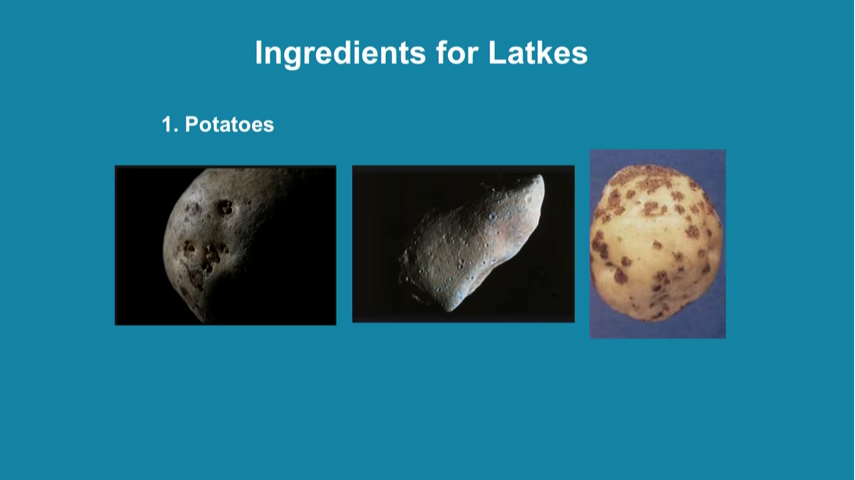
Back to the debate at hand. I will examine the evidence, both historical and recent, for astronomical clues to the question of latkes versus hamantashen. I will make four arguments.
(1) Galileo Galilei is known both as the father of modern astronomy and of modern physics, and he was a well-known connoisseur of Jewish cooking. He was the first to make an astronomical telescope and to look upward at the sky and not only to look at the sky but to record and interpret what he saw. In poring over his notebooks of 1609, I have been able to reveal an overlooked discovery.
In addition to discovering the moons of Jupiter, the phases of Venus, and spots on the sun, Galileo’s notebooks contain hand-drawn and beautiful drawings of latkes. Imagine his surprise when he looked up into the heavens and saw a beautiful, textured, and bubbly image of a hot latke as the batter hits the frying pan and it turns a golden brown. Here is an image from Galileo’s notebook. The phases of making latkes. Galileo wrote, “I render infinite thanks to God for being so kind as to make me alone the first observer of marvels kept hidden in obscurity for all previous centuries.” I, too, now know how he felt.

(2) Edwin Hubble [SB 1910, PhD 1917] changed forever our perception of the universe that we live in. In the 1920s, a debate was raging in the astronomical community. This debate predated our prestigious Latke-Hamantash Debate, and it was almost equally well known, i.e., completely unknown outside of the University of Chicago. Edwin Hubble himself began his distinguished academic career at the University of Chicago. He set out to study the nature of a class of astronomical objects known as nebulae. A person who devotes their life to the study of nebulae is known as a nebulish. That’s to be distinguished from the Yiddish word nebbish, which means pitifully ineffectual, luckless, and timid. You don’t want to be a nebbish. Hubble was not a nebbish. In fact, he was a superb athlete. He played basketball for the University of Chicago, he was a Rhodes Scholar, and he rose to the rank of colonel in World War I. So remember he was a nebulish, not a nebbish. At the heart of the debate was the question: Were these objects nearby new stars in the process of forming or were they distant island universes on their own?
Using the most powerful telescopes in the world, Hubble made a monumental discovery. In the words of my famous late astronomical colleague Carl Sagan [AB’54, SB’55, SM’56, PhD’60], also a University of Chicago alum, Hubble discovered that the universe is filled with billions and billions of galatkes. Hubble found further evidence that these galaxies, as the galatkes are now referred to, are taking part in a global expansion of the entire universe. You think I’m kidding, but I checked the Yiddish-English Dictionary for galaxy. Galaktik. And for the young skeptics among you—most of you are not fluent in Yiddish—I double-checked with the indisputable source of all knowledge: Google. Galaktik. OK, close enough. Galatkes. Even with the powerful Hubble Space Telescope—and I’ve spent much of my career observing with it—you don’t see galhamantashen or any other astronomical objects resembling three cornered pastries with filling.
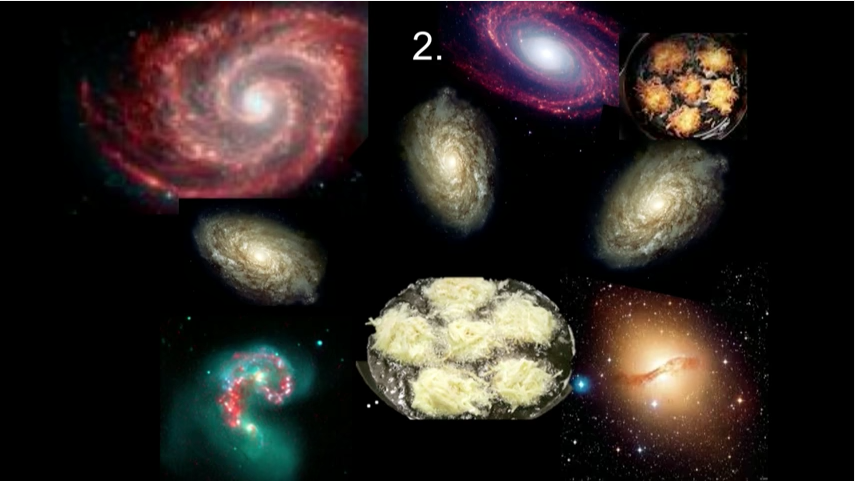
Albert Einstein was so intrigued by Hubble’s discoveries that he traveled to Pasadena, California, and to nearby Mount Wilson, home of the telescope Hubble had used. And Hubble let Einstein peer through the telescope. I looked for a reference to see if Einstein had weighed in on the Latke-Hamantash debate, or if there was a picture of Einstein in the Einstein Archives showing him enjoying either latkes or hamantashen, but I could find no clues. On this important question, Einstein did not leave us his answer, although I think one could make the argument that he was reacting to eating a hamantash, but we’ll debate that later.
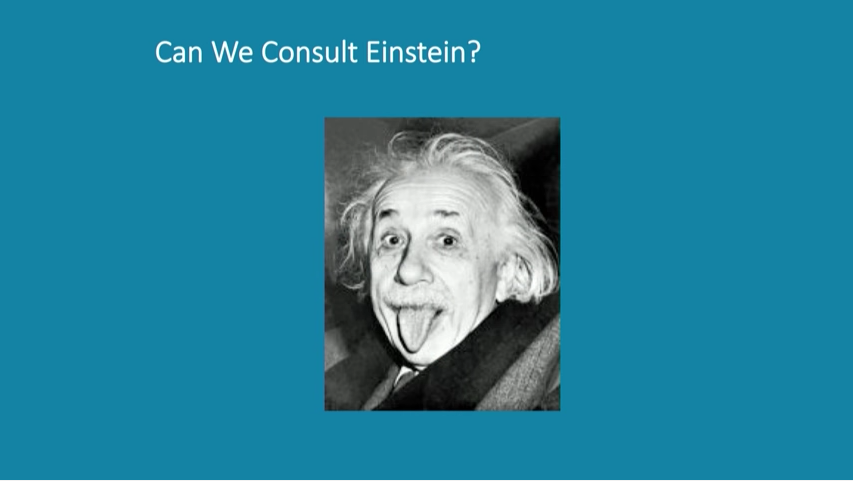
(3) Arno Penzias and Robert Wilson of the Bell Laboratories in New Jersey made a discovery for which they were awarded the Nobel Prize in 1965. If the universe had a beginning hot enough to make the ingredients for latkes and hamantashen, then a relic of this big bang radiation should be observable today, cooled to a temperature of three degrees above absolute zero. Penzias and Wilson discovered this background radiation, and modern measurements have now mapped this background to extraordinary precision. So here is a satellite image of the sky in microwaves. The color scheme is, of course, entirely false. It is intended simply to convey regions of the universe that are colder, in blue, than others, in red. The astronomers who chose this particular color scheme, however, have missed the opportunity to make a profound discovery, clearly evidence that the cosmos resembles a giant latke.
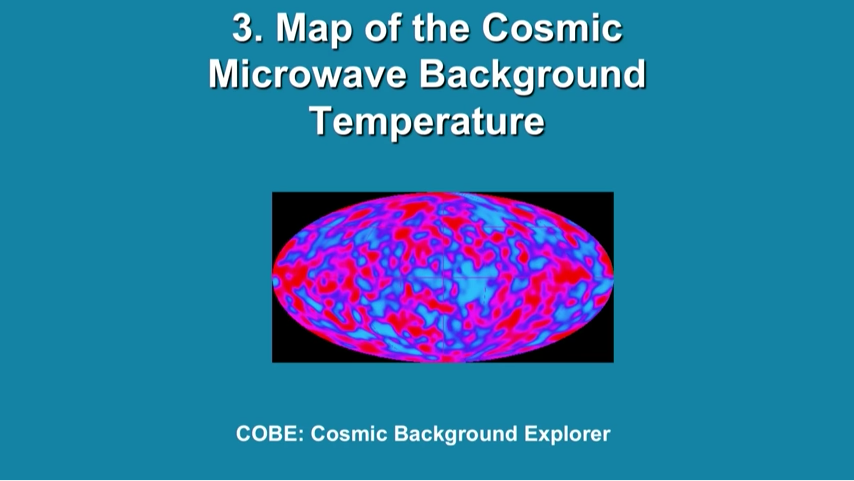
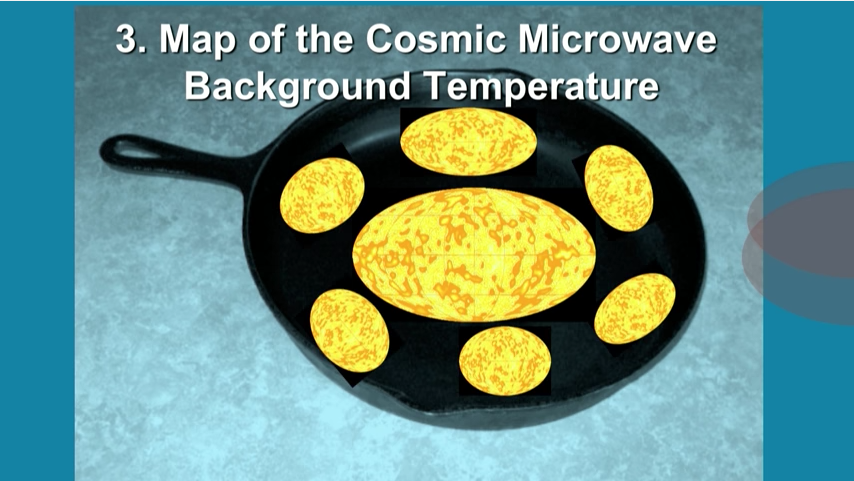
Finally (4) This audience gets ahead of you. I guess you are familiar with the 27-kilometer long tunnel in the countryside running underground near the Swiss-French border outside of Geneva. It is known as the LHC, or Latke Hamantash Cooker. It is here that the World Wide Web was created in the early 1990s, presumably when Al Gore went there to learn of experiments intended to answer the question of which is better, latkes or hamantashen.
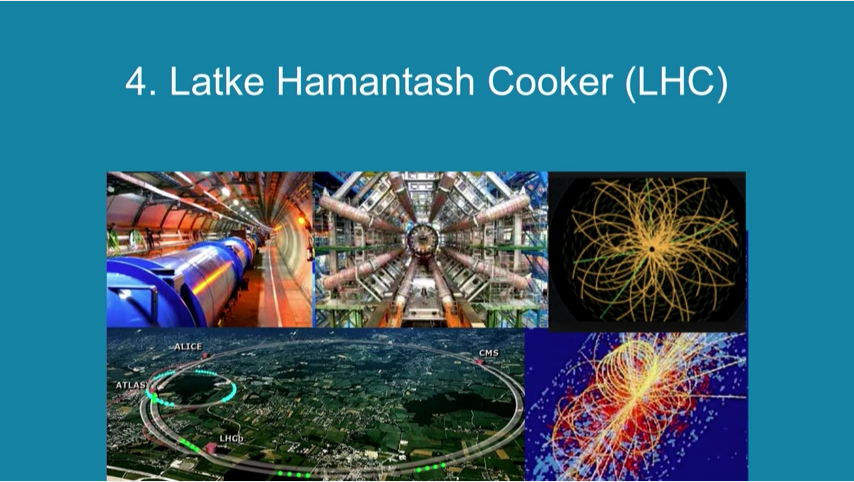
Test particles, latkes and hamantashen, are being smashed into each other at astronomical energies, accelerated to nearly the speed of light, creating showers of particles in order to learn about the fundamental constituents of matter. A host of other particles appear very briefly, particles that have not been seen since the big bang 13.7 billion years ago. What do we see from these collisions? Well, like the childhood game, which of these images is not like the other? Shower of particles created in the Latke Hamantash Cooker, a latke, a hamantash.
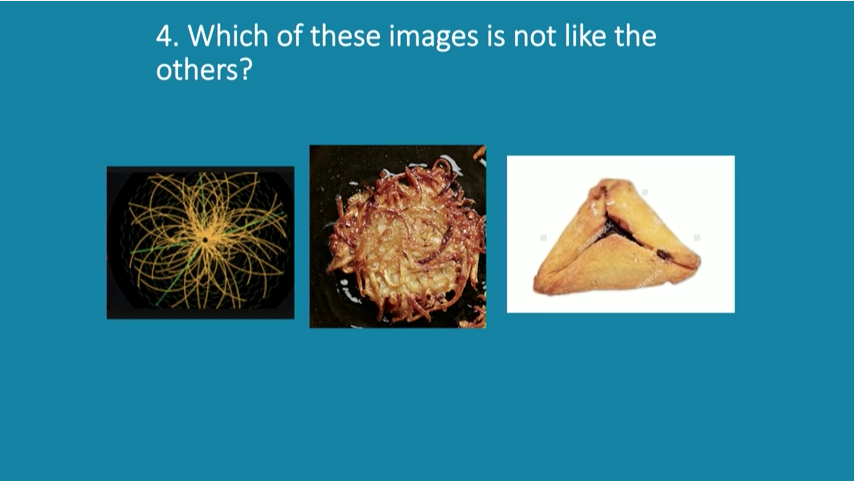
A three-year-old could answer this question. You don’t need a PhD scientist. Sure, the LHC discovered the Higgs boson, whatever that is. But I say Higgs schmigs. The great discovery justifying the modest investment in the LHC of $10 billion was that, just as the cosmos is full of potatoes, the submicroscopic world is shaped like a latke.
And so I rest my case. Clearly, the empirical evidence from astronomy and physics gathered over a period of centuries indicates that the cosmos has a preference for latkes over hamantashen. We see it on all scales from the smallest particles, to our asteroid belt filled with potatoes, to an expanding world of galatkes, and an imprint of latkes on the grandest scale—that of the universe itself. Thank you very much.
Video
The Latke-Hamantash Debate has been a University of Chicago tradition since 1946. UChicago faculty members apply the knowledge and tools of their disciplines to resolve this age-old question in an evening of fun and frivolity! Past participants have included Nobel Prize winners and University presidents. Spectators gathered in Mandel Hall for yet another attempt to resolve this question once and for all.
